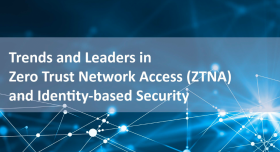Why Is ZTNA Important and Who Are the Leaders?

Yes, zero trust is the new hyped element for cybersecurity. In case you were wondering what zero trust means – it means you should trust nobody (or nothing).
On the networking front, zero trust network access (ZTNA) takes the zero-trust concept to the network, using new techniques such as identity authentication and applications behavioral analytics to make sure the folks connecting to networks and applications are who they say they are.
Why Is ZTNA Interest Rising?
Expect ZTNA to be a continued area of focus for networking and cybersecurity companies going forward, which will drive mergers and acquisitions as this market consolidates.
ZTNA interest has risen in recent years, with significant venture capital (VC) investment as well as investment by larger companies building out their portfolios. Futuriom has been tracking at least 30 companies in this market -- with hundreds of millions of dollars in funding.
A few big trends have fallen into place to raise the need for ZTNA. The cloud has accelerated how people connect to the Internet and applications. Remote work has made it more difficult to secure users and application access for the hybrid workforce.
With these trends in place, enterprises are increasingly looking for more sophisticated ways to guard networks and data, as the attack vectors increase with cloud and Internet use.
What Is ZTNA?
The ZTNA architecture assumes that everybody and everything is the bad guy. It is more a philosophy than a specific technology, but it has important implications for emerging cybersecurity technologies, especially in the networking area.
The National Institute for Standards and Technology (NIST) describes zero trust as: “A collection of concepts and ideas designed to minimize uncertainty in enforcing accurate, least privilege per-request access decisions in information systems and services in the face of a network viewed as compromised.“
NIST believes that a zero-trust strategy is “primarily focused on data and service protection but can and should be expanded to include all enterprise assets (devices, infrastructure, components, applications, virtual and cloud components) and subjects (end users, applications and other non-human entities that request information from resources.”
Many ZTNA systems as well as cybersecurity tools function in a similar way: Collect as much data as possible from different sources, then process or analyze that data in a policy engine that can determine if user access is legitimate or a threat. These sources can include:
• User credentials
• Network devices (routers, switches)
• Devices and endpoints
• Log files
• Applications workloads: For example, virtual machines (VMs) or containers
• Cloud or applications data
• API sources such as single sign on (SSO), security information and event management (SIEM), identity managers, threat intelligence databases
Who Are the Leaders in ZTNA?
Futuriom recently did a deep dive on the the ZTNA technology market, identifying the key trends and market leaders. This included an examination of all of the public companies and private companies involved. As mentioned, ZTNA is a hot area of VC investment these days, with more than 30 active startups. Some startups in this area have recently received big rounds – for example Perimeter 81 just recently raised a $100 million C round in June.
ZTNA is likely to be a fertile area of acquisition, with 20 major public cybersecurity companies adding ZTNA products and solutions. There have already been some deals in this area, notably Juniper Networks’ acquisition of WiteSand earlier this year.
While recent VC funding for ZTNA remains robust, it’s likely to slow down. Valuations were too high in the startup market and the VC market is retrenching. With interest rates having risen substantially and tech markets down, 2021 valuations at greater than 20X sales are no longer sustainable.
Consolidation is coming in the ZTNA vendor market. With a VC slowdown and more than 20 strong ZTNA startups in the market, larger companies will make acquisitions to fill out ZTNA portfolios. The drop in startup valuations will be opportunistic for public companies that have the cash and equity to make plays.
Many public companies have positioned themselves as ZTNA leaders – though they may need more technology to fill in parts of their portfolio. Some of the public companies to watch as this market develops include Akamai, Appgate, Cisco, Cloudflare, Fortinet, Jamf, Juniper Networks, Okta, Palo Alto Networks, VMware, and Zscaler.
Citrix, which recently went private, is also one to watch, along with another private equity company, Barracuda.
On the startup side, look for companies to either raise more funding to take it to the next level or look for deals to exit. Some of the key startups to watch include Axis Security, Banyan Security, Cato Networks, Cyolo, Elisity, Infiot, Illumio, NetFoundry, Netskope, Perimeter 81, Teleport, Versa Networks, Wandera, Waverly Labs, Zentera Systems.
Some of these companies are even approaching maturity for potential Initial Public Offering (IPO). The companies I’d identify at the stage of development to start considering an IPO include Cato Networks, Netskope, and Versa Networks. All of this makes ZTNA an exciting niche cybersecurity market to watch over the next year.






















